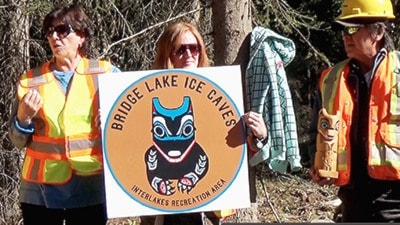A hidden gem, with a lengthy history that goes back to the Aboriginal Peoples and eventually homesteaders, in the Interlakes area is getting a huge makeover.
The Bridge Lake Ice Caves have been a bit of a secret that area residents held for their own pleasure, but for the most part, members of the general public may have heard about them but never visited.
An old trail into the caves and crevices required climbing over blow down trees, marshy areas and picking your way through the brush under the canopy of large trees.
The trek was worth it in the spring and early summer as the closer a hiker got to the crevices the cooler the temperature.
The unique geology of the southern slope of Bridge Lake shoreline features caves and crevices that are sheltered from sun and wind.
Melting snow seeps through the rock crevices into the caves where it refreezes, creating almost a year-round supply of ice.
Historical stories tell us this resource was used by both the First Nations and early European settlers.
However, the spectacular rock formation, the Ice Caves lacked any safety features.
The crevices are slippery and dangerous to navigate in parts.
There was talk about opening up this geological and historical gem to the general public, which meant the site also needed safe parking, a low-mobility trail and safety measures had to ensure the caves and crevices were safe for public viewing.
(Read the story about how the seed of a plan grew through the effort of many groups and individuals in the Sept. 22 edition of the 100 Mile House Free Press.)
Marking a milestone
The Ice Caves at Bridge Lake are known to the local First Nations as the “Entrance to the Bear World.” The site is being transformed into a unique, family-friendly heritage area that incorporates fitness and recreation components, while paying tribute to the First Nations who used the Ice Caves originally.
The “Entrance to the Bear World” will feature beautiful local First Nations animal artwork.
The crowd at the Sept. 13 event marking a milestone in the Ice Caves Project at Bridge Lake got a sneak peak of the beautiful Indigenous art that will greet visitors once work on the site is completed.
“This amazing artwork will create a truly unique experience for the visitors,” says Helga Zeiner, Ice Caves Heritage Trail co-ordinator.
When the project is finished, two totem poles with bear top symbols will greet visitors at the entrance to the parking area off Highway 24. They’ll be carved by Canim Lake Band artist Jerome Boyce who helped unveil a miniature totem pole to give the crowd a preview of the full-sized carvings to come.
A project logo created by local artist Jil Freeman and based on Boyce’s totem design was also unveiled at the event.
The unveiling of the totem pole and local event also provided attendees a glimpse at the work being done at the site as part of the Jobs Creation Partnership (JCP) Project.
The JCP Project is providing much-needed amenities for the Ice Caves complex, including an upgraded parking lot, trail and bridge construction and outhouse facilities.
The Ice Caves Project is led by the Fishing Highway 24 Tourist Association (FHTA), one of the partners in the JCP Project.
The other project partners are the New Pathways to Gold Society (NPTGS), Canim Lake First Nation, Gold Rush Snowmobile Trail Regional Management Committee and the governments of Canada and British Columbia.
“This project is helping to create an outdoor recreational destination that will promote tourism, strengthen the Interlakes infra-structure and benefit local families and visitors alike,” says Cheryl Chapman, NPTGS First Nations co-chair.
“And it’s tremendous to see so much First Nations tradition interpreted and expressed at this site.”
In addition to the two totems for the entrance, Boyce will carve smaller posts for the fitness stations to be built at the site.
Each post will feature a traditional animal representing the Bridge Lake area. Raven, Beaver, Owl, Eagle, Otter, Wolf, Coyote and Loon posts will be installed.
The FHTA has been an incorporated not-for-profit association under the Societies Act since 2011. The association represents members which offer services to visitors and locals alike.
Bridge Lake and the Ice Caves are located in the Interlakes area on Fishing Highway 24, midway between Lone Butte (Highway 24) and Little Fort on Highway 5, some 56 kilometres southeast of 100 Mile House.
NPTGS is a non-profit, non-partisan organization working with communities along the Gold Rush/Spirit Trails corridor from Hope to Barkerville. The society is dedicated to heritage tourism, First Nations reconciliation and economic development.
Visit its website at www.newpathwaystogold.ca.
